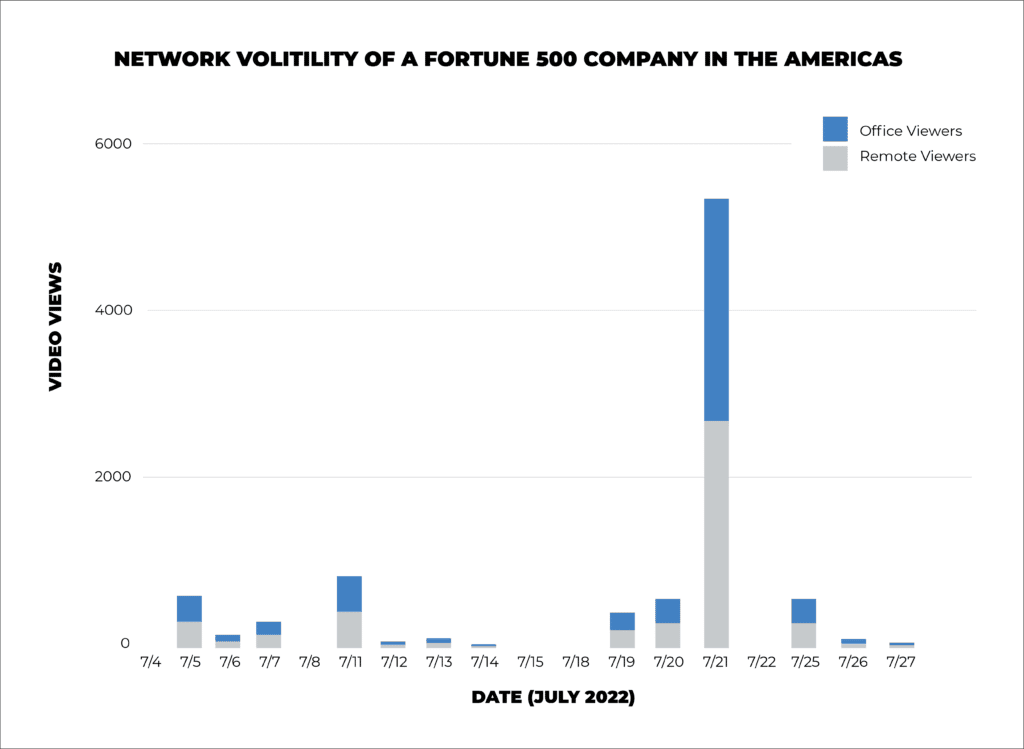Enterprise communications and IT teams that previously had success delivering events to fully remote audiences during the pandemic are facing challenges as employees return to the office. In flexible work models, employees do not come to the office as frequently as they did before pandemic. However, when they do come, it is often en masse and unpredictable, creating peak demand problems for networks. Network volatility like this is becoming a common phenomenon that enterprises across all verticals are experiencing.
What is Network Volatility?
Network volatility occurs when there is a shifting number of concurrent streams running across a corporate network. In the hybrid work model, the number of employees working in an office on a given day is in constant flux. On low-demand days when fewer people are on-site, networks may perform well enough to deliver video to employees without trouble. However, on high-demand days when in-person attendance is greater, networks not equipped with an ECDN are pushed beyond their limits. When this occurs, live events fail and business-critical cloud applications crash, leaving leadership and employees frustrated.
Network Volatility Case Study
To better illustrate network volatility in the hybrid world, we’ll explore typical Teams Live Event consumption for a Fortune 500 Kollective customer during July 2022. This company has a strong global presence, with offices spread throughout EMEA, APAC, and the Americas.
The graph below presents the day-to-day variance of Teams Live Event viewership for one office in the Americas. For most days in July, fewer than one hundred employees consumed live video on-site. However, on six separate days in July, several hundred employees streamed live events from the office, including one day in which on-site viewership nearly crested three thousand. If this office had not been equipped with Kollective’s ECDN, their network would have faced complications on each day when on-site viewership topped one hundred and would have suffered a complete failure when it nearly exceeded three thousand.

Our next example within this company takes us halfway around the world to an office in APAC. For most days in July, several hundred-person live events were streamed on-site. There were nine days where on-site viewership surpassed five hundred, including two days where it topped eight hundred and one thousand three hundred, respectively. Notice that while the average in-person attendance and the days of highest attendance vary between this office and the one in the Americas, both offices experience highly varied on-site video consumption and a high level of network volatility over a short timeframe.
Network Volatility is Inevitable in the Modern Workplace
In hybrid work models, network volatility is unavoidable – it’s not a question of if, but when. For businesses with a lower baseline of in-person attendees, it’s easy for leaders to develop false faith in their network’s ability to successfully deliver live video. Take the three offices in the graph below as an example. For four days during the week, a relatively low number of employees stream video at each office. However, each office also experiences one day in which in-person viewership spikes well above their day-to-day norm.
This phenomenon represents the reality that businesses are confronted with in the modern workplace. While these offices may have been able to successfully deliver video without an ECDN on the days when fewer streams were consumed in-office, their networks would have collapsed on the days when consumption spiked. With an ECDN, however, this is not a problem. ECDNs are not only a cost-effective and secure solution, but one that businesses can rapidly deploy across the enterprise to ensure that when their network experiences volatility, they can still depend on it to reliably deliver video to all employees.
Small Offices are Not Immune
In the examples above, we explored network volatility in large offices. While network spikes in large offices may seem more significant, volatility in small offices can be equally problematic. In the graph below, one of this company’s smaller offices in EMEA experiences two days in July when in-person viewership crests one hundred and six days above fifty. These spikes are not as dramatic as the ones we presented above but can have a similar impact on an office of this size. Whether an office is large or small, its infrastructure is very rarely built to natively supply the bandwidth required to deliver concurrent video to all potential on-site employees during company wide live events. A cost-effective solution like an ECDN can alleviate bandwidth issues for offices of all sizes.
No Matter How Volatile the Network, Kollective Delivers
These examples are not unique – offices throughout this organization and others experience network volatility on a regular basis. Without Kollective’s ECDN, the network would have failed to deliver live events on the days when on-site viewership spiked. It’s also important to note that this is not a company that has fully returned to the office, but one that is embracing the flexibility of hybrid work.
Network volatility is an unavoidable reality in the modern workplace. It can create frustration and roadblocks for organizations which can easily be avoided by putting an ECDN in place. ECDNs ensure that as people return to the office, the network is empowered and able to successfully deliver live video to all employees, regardless of their location. Ease the transition to hybrid work and provide your business with the confidence that your network will always work.
